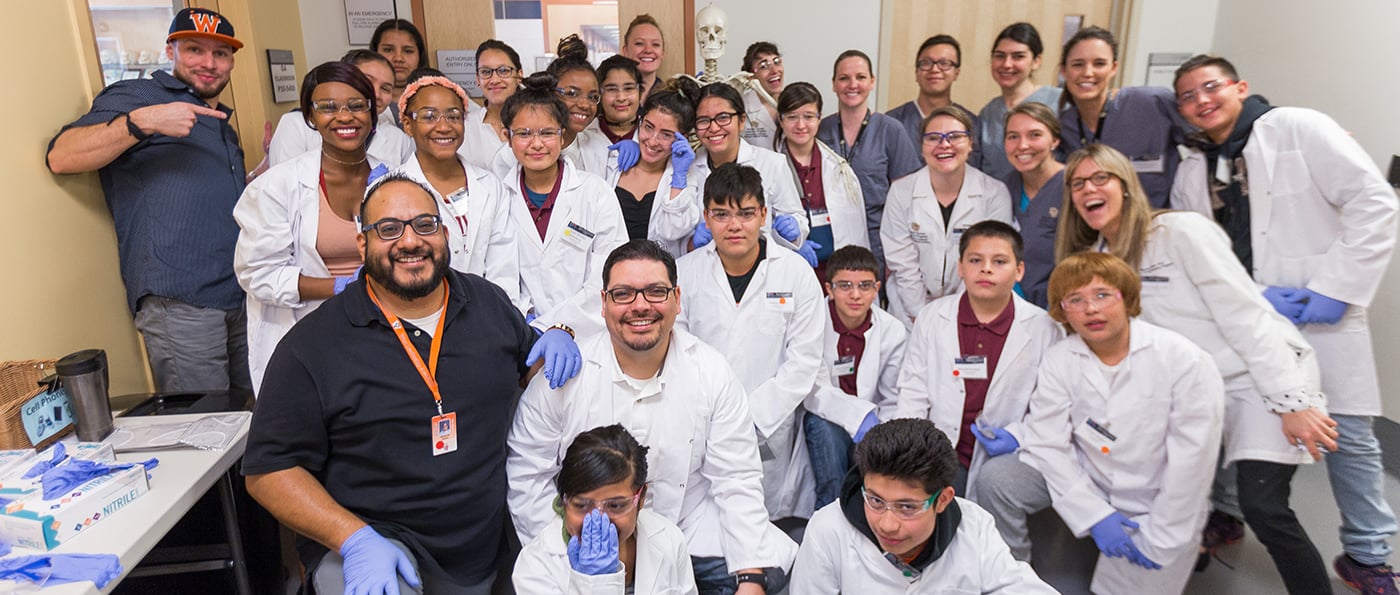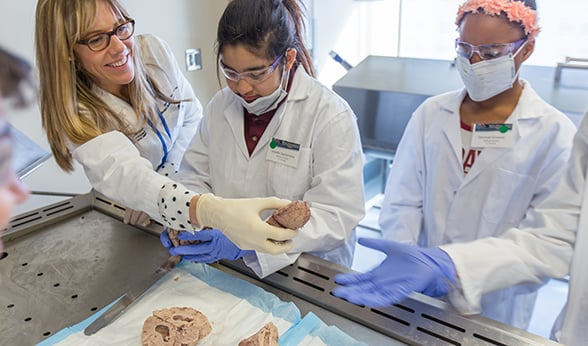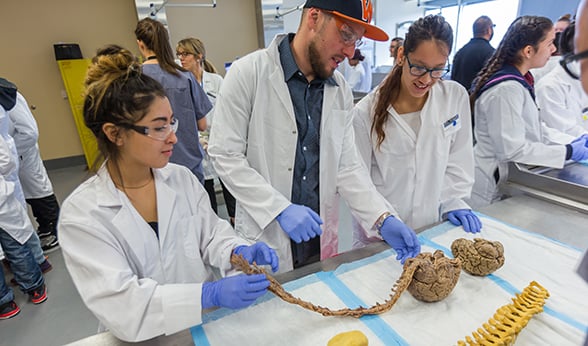 Students and teachers at West Leadership Academy visit CU Anschutz as part of the WeLLCOMe Program.
Students and teachers at West Leadership Academy visit CU Anschutz as part of the WeLLCOMe Program.
As soon as 20 middle school students step into the hall and put on white lab coats and glasses, a noticeable change comes over them. There’s a sense of confidence, of feeling important.
“It feels like I’m a scientist,” Denajsha Vialpando says while flashing a smile. “It just feels like I’m working here, like I’m a medical student.” Another eighth-grader, Jacqueline Tarin, adds, “I feel like I’m in health care training. When I grow up I want to dissect brains and stuff like that.”
Just down the hall in the “bone room,” they will perform a cranial nerve exam, slice away slivers of brain, and study the three-dimensional images of the Visible Human.
This hands-on exploration of science, health and health careers is the idea of the WeLL-COMe Program at the University of Colorado Anschutz Medical Campus. WeLL-COMe stands for Wellness, Lifelong Learning and Career Orientation Mentorship, and it’s geared toward middle-school students.
The program is a collaboration between the Department of Neurology, the Department of Cell & Developmental Biology, the master’s program in Modern Human Anatomy – all within the CU School of Medicine (SOM) – and Colorado Uplift, a nonprofit that provides guidance to underrepresented minority students. This spring, six waves of students from Denver and Aurora schools will participate, touring in groups of 10 to 25 students.
‘Change in their mindset’
On a recent morning, the group from Denver’s West Leadership Academy tours the anatomy labs on the fifth floor of Education 1. They are led through various health stations, including the brain dissection room, by several graduate-student volunteers from the Modern Human Anatomy program.
 Maureen Stabio, PhD, assistant professor in the Department of Cell & Developmental Biology, hands students from West Leadership Academy parts of a human brain to inspect.
Maureen Stabio, PhD, assistant professor in the Department of Cell & Developmental Biology, hands students from West Leadership Academy parts of a human brain to inspect.
The group starts with an introductory lesson in neurons and brain plasticity. “We teach the students that their brains have enormous capacity to learn and change. Through practice and hard work, they can do science,” says Maureen Stabio, PhD, assistant professor in the SOM’s Department of Cell & Developmental Biology. “I think that change in their mindset is important.”
Hannah Benjamin, an anatomy graduate student, enjoys volunteering for the outreach sessions because they blend two of her passions – working with kids and studying human anatomy. “My favorite part is getting in the labs and doing hands-on work, because I don’t think this kind of opportunity is as available for middle school students as it is for high school students,” Benjamin says. “Watching their faces when they pick up a brain makes my day.”
 Denajsha Vialpando, left, a student at West Leadership Academy, and fellow student Jacqueline Tarin, right, perform a cranial nerve exam along with a teacher from the academy, in the bone room in Education 1 at CU Anschutz.
Denajsha Vialpando, left, a student at West Leadership Academy, and fellow student Jacqueline Tarin, right, perform a cranial nerve exam along with a teacher from the academy, in the bone room in Education 1 at CU Anschutz.
She says the students are especially fascinated by the brain slicing and cranial nerve demonstrations. When Vialpando steps up to cranial nerve station, she’s repulsed and fascinated at the same time. “Oh my God, are those eyes?!” she exclaims as she grasps the eyeballs dangling from slender nerves. In her next breath, the eighth-grader asks the graduate student, “What’s this black thing?” as she points to a blood vessel at the base of a brain.
“It’s squishy,” another student observes as he touches the gray matter.
Opening doors to science
Veronica Contreras de Raya, marketing and communications coordinator for Colorado Uplift, says the CU Anschutz outings leave a profound impression. “A lot of kids don't consider a future in math or science as a possibility, so this kind of hands-on experience can really open doors,” she says.
Colorado Uplift is an essential collaborator for the program, says Alina Rich, education manager in the Department of Neurology, since the organization has strong connections to schools across Denver and Aurora.
In fact, the 3-year-old WeLL-COMe program, which is funded by the Maggie George Foundation, this year expanded to include Aurora Public Schools, joining Denver Public Schools students in the lab rotations.
Benjamin, who helped develop the outreach curriculum, has been accepted into the CU SOM for fall 2017. She’s delighted that she will be able to continue promoting healthy lifestyles and interest in health professions among middle school students.
“Hopefully some of them will walk out of here wanting to wear a lab coat again and be a doctor, nurse or other health care professional someday,” Benjamin says.
